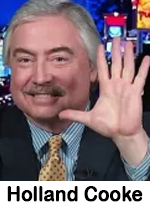CES100th, Radio Roots
By Holland Cooke
Consultant
 If you’ve been seeing CES coverage on network and cable newscasts this week, you’ve heard it called “the Consumer Electronics Show,” despite we-the-media being told not to. They want us to say “CES,” although, years ago, the Consumer Electronics Association changed its name to the Consumer Technology Association, not its first rebrand.
If you’ve been seeing CES coverage on network and cable newscasts this week, you’ve heard it called “the Consumer Electronics Show,” despite we-the-media being told not to. They want us to say “CES,” although, years ago, the Consumer Electronics Association changed its name to the Consumer Technology Association, not its first rebrand.
Back in 1924, it was the Radio Manufacturers’ Association, and eventually it became the Radio & Television Manufacturers’ Association. For all those years – and for decades after it morphed into the CEA – this organization advocated for companies that made… things.
Back-to-the-future: Many of the big stories at CES2024 aren’t about products that come in a box. Artificial Intelligence is big here this year, nonchalantly referred to as “AI.” But – because we should avoid initials that aren’t self-explanatory – you’re hearing CES called “the Consumer Electronics Show;” and smart reporters use “Artificial Intelligence” on first reference.
And one particularly insightful session I attended got me thinking about radio’s “initials.” When we say our call letters, do listeners think about what we were, or what we can do now do?
“All Media is Social Media” panelist Isabel Perry, VP of emerging technology at pioneering digital agency DEPT said a mouthful, in a savvy British accent: “Your brand is not what you tell your customers. It’s what your customers tell each other about you.” And declaring that “media is now communal,” fellow panelist and former TikTok executive Melissa Eccles urged “Invite people to participate.”
Robotic music stations with too many commercials are disadvantaged. Swifties don’t need FM to hear Taylor. She’s already on their phones…and Alexa, and SiriusXM, and YouTube, and streams. Talk radio that’s I-talk-you-listen is a caricature. Media consumers expect to interact. As Larry King said, “I never learned anything while I was talking.”
Yes, there are huge TVs and flying cars here, and CES is still gadget heaven. But 100 years ago – when families sat around large AM receivers, seeming to watch what they were hearing – simply broadcasting at-them was a business. I leave Las Vegas reaffirmed that ENGAGING people is now, in gambling parlance, table stakes.
Covering CES this week for TALKERS, I’m also offering stations 60-second reports. Help yourself at HollandCooke.com.
Holland Cooke (HollandCooke.com) is a consultant working at the intersection of broadcasting and the Internet. He is the author of “Close Like Crazy: Local Direct Leads, Pitches & Specs That Earned the Benjamins” and “Confidential: Negotiation Checklist for Weekend Talk Radio.” Follow HC on Twitter @HollandCooke



 A beautiful night. Paul Galvin and William Lear took their girlfriends to a romantic look-out view. Paul asked, “Isn’t this great?” His girlfriend replied, “It would better if we could hear music.”
A beautiful night. Paul Galvin and William Lear took their girlfriends to a romantic look-out view. Paul asked, “Isn’t this great?” His girlfriend replied, “It would better if we could hear music.”